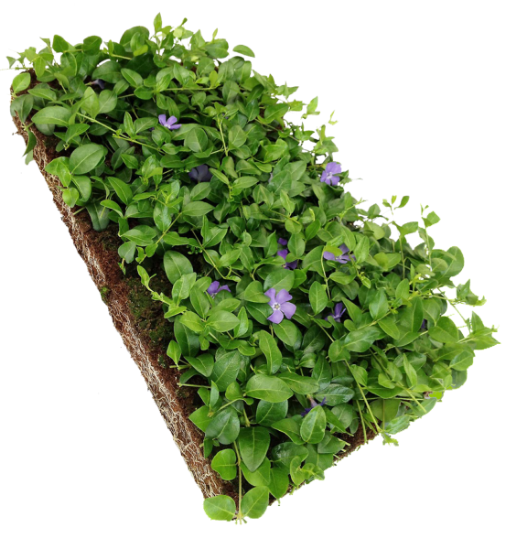
Green roofs are getting more and more common, with Sedum as the most well known plant mat. Besides that, we see a growing market for our other plant mats, which are also suitable for placing on a rooftop. With our collection we meet the need for variation and other plants on a vegetation roof. This growing variety also stimulates the biodiversity in urban life.
A roof garden or green roof can be distinguished in 2 different varieties: extensive and intensive.
An extensive roof garden is the light weight version and needs little support of your roof construction. Extensive roof gardens are limited in their planting possibilities, but our Covergreen plant mats like the Sedum (Stonecrop) and our colorful Delosperma Cooperi are the solution. Our ready to use ground covers need a substrate thickness of max 15 cm, an weigh up to 250 kg per m² (when fully saturated by rain, plus a thick layer of snow). If you want to know if your roof is suitable for a green garden, please contact your constructing expert. Present gravel is already a good indicator your roof is calculated on a higher roof weight.
Intensive green roofs provide nearly unlimited possibilities. It is even possible to plant a tree, lawn or footpath for example. Your roof will become a small park! As you will understand, a bigger substrate layer is needed, to create a larger buffer for the roots.
The Covergreen ready-to-use plant mats can be applied on both roof gardens. A substrate layer of 15 cm under the plant mats is optimal, but thinner substrate layers are also optional. Please note: a thinner substrate needs extra water in dry times. Thicker layers will provide a better buffering of fertilizer and lesser rising out.
Roof gardens adjust to the biodiversity in the urban environment. Blooming plants are an important source of food for insects. With that, insects fertilize the plants. And insects are an important food source for birds, which therefor enlarges their living space.
In the past years we see an increase of rain. At the same time this rain can hardly penetrate the soil because of hardening. Therefor the sewer system needs to drain large amounts of water. municipalities need to buffer this water during extreme rainfall, to unburden the sewer. Green roofs help by taking in the rain on a temporary base, to release it slowly afterwards.
Green keeps the urban temperature from rising too fast. Green does not store the heat like concrete, asphalt and metals do. On top of that, green roofs help isolating buildings.
Fine dust
Sedum roofs are known for their ability to store fine dust. But did you know Hedera and Waldsteinia can take in even more fine dust? So, when fine dust is the mean reason to choose your green roof, please consider Covergreen Hedera or Covergreen Waldsteinia as an even better choice. These plants help optimizing the air quality in urban environment. In contrast to people, animals and for example engines that need oxygen, plants can turn CO2 into oxygen by photosynthesis, which makes them an important part in CO2 reduction.

Copyright © 2018, Covergreen®, All Rights Reserved. Ontwerp website ®reclamemakers. Development website Sitework